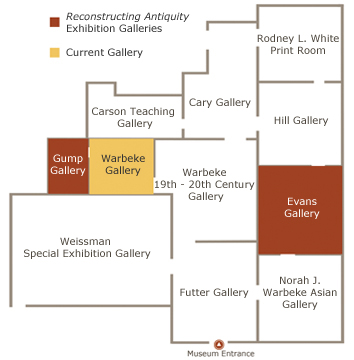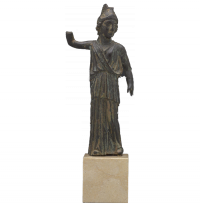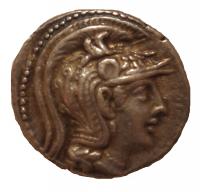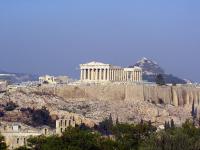Standing figure of Athena
Learn more about the object below
Almost always depicted with warlike attributes, including a helmet, spear, and shield, the virgin goddess Athena was the patroness of many of the most famous heroes of Greece, including Herakles, Achilles, Jason, Theseus, Perseus, and crafty Odysseus. Athena offered protection and guidance to the men both in and out of battle. In the epic poem The Odyssey, for example, she offers advice to Telemachos, son of Odysseus, while disguised as Mentor (hence our use of “mentor” as a term for a counselor or teacher). The daughter of Zeus and the cunning Metis, she was also the goddess of strategic warfare and crafts, such as weaving.
After defeating the invading armies of Persia twice in ten years, Athens became the pre-eminent Greek city in the 5th century BCE and the head of the Delian League, an alliance of cities set up to defend Greece against attack. The city was dedicated to Athena, who, according to legend, won it in a contest against Poseidon, god of the sea. This event was depicted in the sculptural decoration of the Parthenon. The Parthenon was one of several structures dedicated to Athena built on the acropolis with funds from the Delian League treasury. The ruins of the Parthenon, severely damaged by bombardment in the 17th century, still rise above and serve as the iconic structure of Athens.
Large-scale ancient sculptures, some of which were made of bronze, have not generally survived. Later artists copied life-sized or colossal statues in more durable materials, such as marble, or in formats that were more frequently preserved, such as small-scale statuettes. A number of famous sculptures of the goddess Athena are known to have existed on the Acropolis in Athens in the 5th century, including a bronze statue of Athena Promachos (“Attacking”) and, within the Parthenon, a gold and ivory statue of Athena Parthenos. Both were the creations of Pheidias, the most famous sculptor in Greece, who was responsible for the decorations of the Parthenon and for the statue of Zeus at Olympia, which ancient authors called one of the Seven Wonders of the World.
Label text by Lisa Anderson, Frederick Randolph Grace Assistant Curator of Ancient Art, Harvard Art Museums.
Suggested readings:
M. P. O. Morford and R. J. Lenardon, Classical Mythology, 7th edition, Oxford University Press, 2003.
J. McK. Camp, The Archaeology of Athens, Yale University Press, 2001.
C. C. Mattusch, Classical Bronzes: The Art and Craft of Greek and Roman Statuary, Cornell University Press, 1996.





